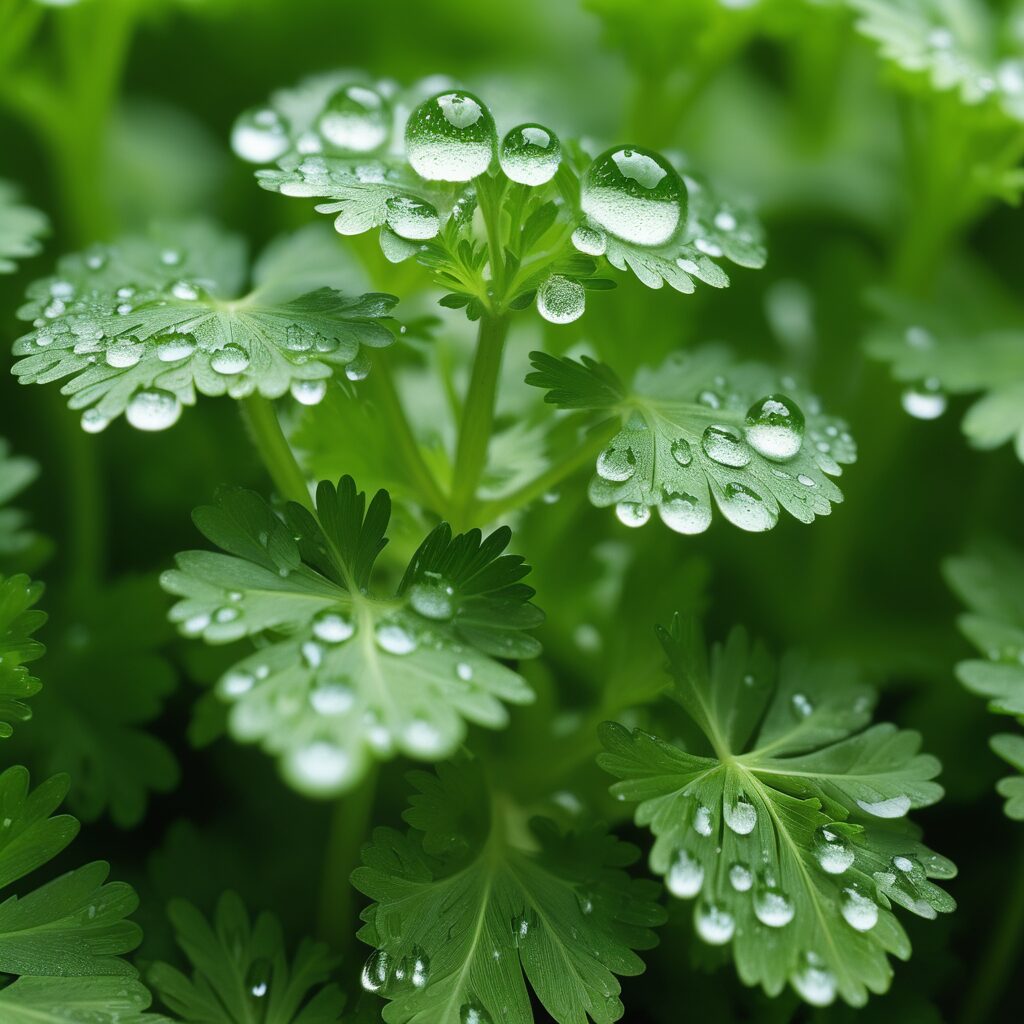Parsley, often underrated as a simple garnish, is a herb with a rich history and a plethora of medicinal benefits that deserve recognition. Its journey from a seed containing the creative essence of earth and sun is a true marvel of nature. As the seed germinates, it initiates a transformation that embodies the unity of various natural elements. These elements, alongside the colors of green and orange, represent the life-giving energy that drives parsley’s growth. The color orange symbolizes vitality, primarily noted in its role in creating vitamin C, while green stands for the life force of chlorophyll, converting sunlight into sugars that sustain life.


Through time, parsley’s vivid greenery has also told tales of the earth and sun’s collaboration, fostering not only a plant but a vibrant symbol of health and life. As parsley matures, its vibrant green leaves, infused with the beneficial essence of vitamin C, capture both the spirit of life and nourishment. This symbolism reflects not just a culinary ingredient but a link between colors and elements that nurtures our health beyond what meets the eye.
Originally, parsley had associations with death, bearing connotations that sparked both fear and reverence. Its use in funeral rites and as protection against evil spirits highlighted its perceived power in ancient times. This enduring symbolism transforms parsley from a mere garnish into a plant steeped in myth and history. Its hardy nature, thriving even in graveyards, might have reinforced its mystical aura, linking it to the afterlife.
Apart from its storied past, parsley is rich in chlorophyll, known for its deodorizing properties. Famous remedies such as chewing parsley for fresh breath and using it as a natural deodorizer have been practiced for centuries. With its ability to neutralize odors, it serves not only culinary purposes but also enhances personal and home environments. In my personal journey of understanding parsley, I experimented by boiling its leaves as a natural deodorizer, effectively neutralizing stubborn aromas in my home.
Parsley’s use extends beyond odor control; it finds a place in herbal wines, blending traditions with modern culinary practices. It offers a delightful herbal infusion that connects us with historical uses in the Middle Ages when monks crafted these concoctions for both taste and medicinal purposes. These practices were rooted in understanding the health-promoting attributes of herbs, with parsley being favored for its diuretic and digestive benefits.
The exploration of herbal wines illustrated how these past traditions have shaped contemporary views of herbs in wellness and cuisine. The historical significance of parsley wine, fused with other botanicals, reflects a blend of art, medicine, and culinary creativity. Such drinks were believed to balance body functions and were consumed by royalty, monks, and the general populace, embodying a longstanding appreciation of the herb’s restorative properties.
Parsley also stands out as a nutritional powerhouse rich in vitamin C, eclipsing even some citrus fruits. This revelation underscores its role in supporting immune health, transforming perceptions from garnish to a vital dietary component. Parsley’s nutrition is paramount in its application, providing dense nutrients while contributing to culinary diversity.
As a grower of parsley, one can choose between curly leaf parsley for garnish and flat-leaf or Italian parsley for more robust flavoring in culinary applications. The herb is essential in a variety of dishes such as Gremolata, a zesty mixture with parsley, garlic, and lemon zest, which enhances vegetables, fish, and meats.
In the realm of herbal medicine, parsley has profound tales. Stories from herbalists like Dr. John Christopher illustrate parsley’s potential to transform health outcomes. Accounts of individuals overcoming severe ailments with parsley exemplify its role in historic and modern natural healing practices. These testimonies reinforce the herb’s association with health, evoking a mix of awe and respect for its abilities.
Traditionally, parsley was tied to superstitions, believed to attract witches and affect pregnancies. Its perceived magical properties align with practices where it was used to address witchcraft and enhance fertility. Historical beliefs often blurred the lines between food and medicine, providing layers of understanding that enrich how we view parsley today.
A common saying, “be like parsley,” symbolizes omnipresence, idea that parsley is a universal staple appearing in many dishes, much like someone who shows up in diverse situations. It encapsulates both the positive aspects of being indispensable and the potential to overstay—illustrating the balance parsley adds to our lives.
Medicinally, parsley is recognized for its wealth of vitamins, minerals, and antioxidants. The International Herb Association named it the Herb of the Year in 2021, celebrating its extensive use and health applications. Historically used to treat various ailments, including kidney stones and bladder conditions, parsley remains invaluable in modern herbal medicine.
For digestive health, parsley is recommended to ease discomfort, combat cramps and gas, and assist those experiencing cystitis and other urinary issues. Its aromatic oils are appreciated in winter dishes, especially in German cuisine, for aiding digestion. Parsley’s phytochemicals like volatile oils and flavonoids contribute to its health benefits.
Crafting a parsley-rich diet involves adding it to daily meals. Whether in soups, salads, or teas, parsley enhances nutritional intake and digestive wellness. Growing parsley ensures access to fresh leaves richer in nutrients than those found in supermarkets. It can be cultivated in home gardens or pots, thriving well when left to self-seed.
Its role in agriculture extends beyond human consumption; parsley is beneficial for livestock and poultry, enhancing the quality of their produce. Such practices demonstrate parsley’s integration into sustainable farming, supporting larger ecosystem health.
In herbal applications, the potency of parsley seeds, known for their high volatile oil concentration, should be used cautiously. Pregnant women are advised against intensive parsley use due to its potential to induce menstruation. The herb’s diuretic and antispasmodic qualities make it essential for supporting kidney function and appetite stimulation.
Historically, herbalist Nicholas Culpeper noted parsley’s mercury alignment and its benefits in easing stomach and menstrual issues. Modern recognition, such as the German Commission E, acknowledges its support in urinary health. Parsley’s antioxidant strength benefits overall cellular health, potentially aiding in cancer defense.
Emphasizing parsley’s medicinal capacity underlines its crucial role in supporting body systems naturally. Its cleansing and revitalizing characteristics align with the principles of detoxification, encouraging an integrated approach to health and wellness. It enhances both traditional diets and progressive health paradigms, affirming its enduring value across generations.




